Mechanism of Rock Mass Detachment Using Undercutting Anchors: A Numerical Finite Element Method (FEM) Analysis
Abstract
1. Introduction
- Nu,m—mean pullout load (load capacity of anchors) [N];
- k1 [N0.5/mm0.5]—calibration factor, accounting for, e.g., units in the model, anchor type, base material, embedment depth, etc.;
- fc—compressive cylinder strength of concrete [N/mm2];
- hef—effective embedment depth [mm].
- —the fracture energy of concrete;
- E—the modulus of elasticity of concrete
- When the head friction coefficient on the rock increases, a limitation of the fracture range occurs and an increase in the initial separation angle α0 takes place;
- An increase in the strength of rocks against breaking causes a limitation of the fracture range, an increase in the initial angle of separation, and a change in the trajectory of tracks for a parabolical one, whereas for a small value more complex trajectories of cracks occur;
- An increase in the Poisson ratio causes a reduction in the initial angle of crack propagation and an increase in the range of fractures;
- An increase in the Young’s modulus favors a limitation of the fracture range and an increase in the initial angle of crack propagation;
- An increase in undercutting head diameter, for other fixed parameters, does not cause any essential changes in the conditions of crack propagation in the initial phase of its development;
- An increase in the undercutting head angle limits the scope of separation and favors an increase in the initial crack propagation angle.
2. Materials and Methods
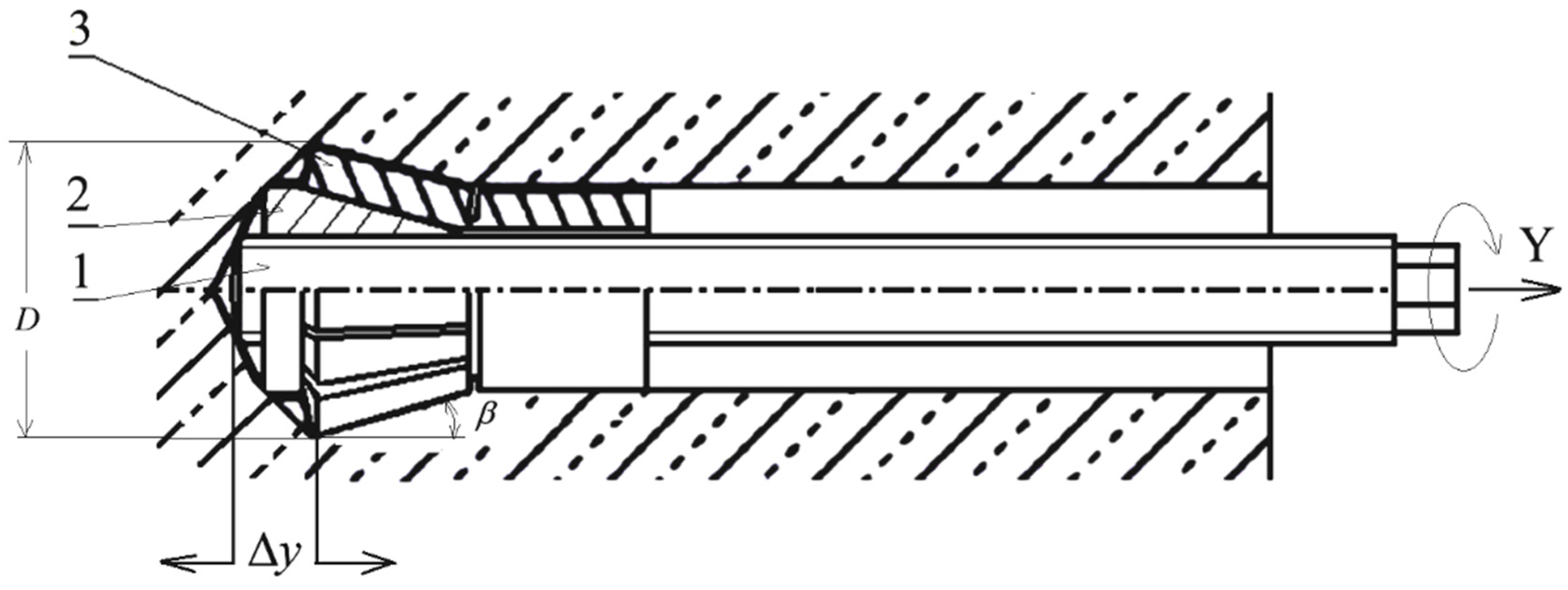
- A type of material and its mechanical parameters were assumed for an analysis: Sandstone: Elastic, isotropic. Elastic modulus—E = 14.276 MPa, Poisson’s ratio—ν = 0.247, Tensile strength—ft = 7.74 MPa.
- Anchor material: Steel: Elastic, isotropic, elastic modulus—E = 210,000 MPa, Poisson’s ratio—ν = 0.3.
- The friction coefficient of steel head and the rock was assumed as follows: µ = (a) 0.2, (b) 0.4, (c) 0.6 (three theoretical cases were analyzed).
- Geometry of anchor and parameters of the pulling-out process
- Depth of anchorage hef = 100 mm;
- Angle of head β = 15°;
- The hypothetical fracture cone angle was initially assumed as α = 22.5°.
- Damage initiation in rock material: Maximal principal stress,
- Damage evolution type: Energy, softening linear.
- Damage for traction—separation laws: Maximal principal stress damage;
- Fracture energy GF = (a) 0.17, (b) 0.355, (c) 0.7 (N/mm)—three theoretical cases were analyzed (in a particular case, linear issues, the fracture energy Gf is coincident with the critical strain energy release rate GIc = KIc2/E [75,76,77,78], where KIc—critical stress intensity factors, E—elastic modulus). Damage stabilization: Cohesive.
3. Results
3.1. FEM Model Results
3.2. Empirical Validation of the Modeling Results
4. Discussion
5. Conclusions
Author Contributions
Funding
Institutional Review Board Statement
Informed Consent Statement
Data Availability Statement
Conflicts of Interest
References
- Isyanov, O.A.; Ilderov, D.I.; Suprun, V.I.; Radchenko, S.A. Landslide Stabilization Experience in Urtui Open Pit Mine. Gorn. Zh. 2021, 102–106. [Google Scholar] [CrossRef]
- Štefaňák, J. Mitigation of the Impact of Landslides in Built-up Areas. In Critical Thinking in the Sustainable Rehabilitation and Risk Management of the Built Environment; Rotaru, A., Ed.; Springer Series in Geomechanics and Geoengineering; Springer International Publishing: Cham, Switzerland, 2021; pp. 496–505. ISBN 978-3-030-61117-0. [Google Scholar]
- Hassan, M.M.; Rahman, N.; Rokonuzzaman, M.D.; Rahman, S. Effect of Anchor Geometry on Uplift Resistance of Plate Anchor in Sloping Terrain. Ocean Eng. 2024, 292, 116498. [Google Scholar] [CrossRef]
- Genco, A.; Ciantia, M.O.; Previtali, M.; Brown, M.; Ivanovic, A.; Cresswell, N.; Twomey, V. Large Deformation Numerical Assessment of Rock Anchor Response under Axial Loading for Offshore Renewable Energy Applications. Comput. Geotech. 2024, 173, 106563. [Google Scholar] [CrossRef]
- Genco, A.; Ciantia, M.O.; Brown, M.; Previtali, M.; Ivanovic, A.; Cresswell, N. MARCO PREVITALI Large Deformation Numerical Analysis of Rock Permeability Influence on Anchor Performance for Offshore Renewable Applications. In Proceedings of the 10th European Conference on Numerical Methods in Geotechnical Engineering, London, UK, 26–28 June 2023. [Google Scholar] [CrossRef]
- Genco, A.; Ciantia, M.O.; Brown, M.; Previtali, M.; Ivanovic, A.; Cresswell, N. G-PFEM Numerical Assessment of Rock Anchor Interface Properties on Pull-Out Capacity for Renewable Offshore Applications. In Geotechnical Engineering in the Digital and Technological Innovation Era; Ferrari, A., Rosone, M., Ziccarelli, M., Gottardi, G., Eds.; Springer Series in Geomechanics and Geoengineering; Springer Nature: Cham, Switzerland, 2023; pp. 427–434. ISBN 978-3-031-34760-3. [Google Scholar]
- Cerfontaine, B.; Brown, M.; Caton, A.; Hunt, A.; Cresswell, N. Numerical Modelling of Rock Anchor Uplift Capacity for Offshore Applications. In Proceedings of the 14th European Wave & Tidal Energy Conference, Plymouth, UK, 5–9 September 2021. [Google Scholar]
- Wu, X.; Jiang, Y.; Wang, G.; Gong, B.; Guan, Z.; Deng, T. Performance of a New Yielding Rock Bolt Under Pull and Shear Loading Conditions. Rock Mech. Rock Eng. 2019, 52, 3401–3412. [Google Scholar] [CrossRef]
- Jonak, J.; Karpiński, R.; Wójcik, A. Numerical Analysis of Undercut Anchor Effect on Rock. J. Phys. Conf. Ser. 2021, 2130, 012011. [Google Scholar] [CrossRef]
- Jonak, J.; Karpiński, R.; Wójcik, A. Numerical Analysis of the Effect of Embedment Depth on the Geometry of the Cone Failure. J. Phys. Conf. Ser. 2021, 2130, 012012. [Google Scholar] [CrossRef]
- Jendzelovsky, N.; Tvrda, K. Probabilistic Analysis of a Hospital Building Slab Foundation. Appl. Sci. 2020, 10, 7887. [Google Scholar] [CrossRef]
- Falkowicz, K.; Debski, H.; Teter, A. Design Solutions for Improving the Lowest Buckling Loads of a Thin Laminate Plate with Notch. In AIP Conference Proceedings; AIP Publishing: Lublin, Poland, 2018; p. 080004. [Google Scholar]
- Wysmulski, P.; Falkowicz, K.; Filipek, P. Buckling State Analysis of Compressed Composite Plates with Cut-Out. Compos. Struct. 2021, 274, 114345. [Google Scholar] [CrossRef]
- Jonak, J.; Karpiński, R.; Siegmund, M.; Wójcik, A.; Jonak, K. Analysis of the Rock Failure Cone Size Relative to the Group Effect from a Triangular Anchorage System. Materials 2020, 13, 4657. [Google Scholar] [CrossRef]
- Szabelski, J.; Karpiński, R.; Machrowska, A. Application of an Artificial Neural Network in the Modelling of Heat Curing Effects on the Strength of Adhesive Joints at Elevated Temperature with Imprecise Adhesive Mix Ratios. Materials 2022, 15, 721. [Google Scholar] [CrossRef]
- Rogala, M.; Gajewski, J.; Głuchowski, D. Crushing Analysis of Energy Absorbing Materials Using Artificial Neural Networks. J. Phys. Conf. Ser. 2021, 1736, 012026. [Google Scholar] [CrossRef]
- Rogala, M.; Gajewski, J.; Górecki, M. Study on the Effect of Geometrical Parameters of a Hexagonal Trigger on Energy Absorber Performance Using ANN. Materials 2021, 14, 5981. [Google Scholar] [CrossRef] [PubMed]
- Falkowicz, K. Experimental and Numerical Failure Analysis of Thin-Walled Composite Plates Using Progressive Failure Analysis. Compos. Struct. 2023, 305, 116474. [Google Scholar] [CrossRef]
- Wysmulski, P. Analysis of the Effect of an Open Hole on the Buckling of a Compressed Composite Plate. Materials 2024, 17, 1081. [Google Scholar] [CrossRef]
- Vita, N.; Sharma, A. Behaviour of Single Bonded Anchors in Non-Cracked and Cracked Steel Fiber Reinforced Concrete under Short-Time Tensile Loading. Eng. Struct. 2021, 245, 112900. [Google Scholar] [CrossRef]
- Eligehausen, R. Connections between Steel and Concrete; Proceedings; RILEM Publications: Cachan, France, 2001; ISBN 978-2-912143-25-9. [Google Scholar]
- ACI 355.2-01; Evaluating the Performance of Post-Installed Mechanical Anchors in Concrete (ACI 355.2-01) and Commentary (ACI 355.2 R-01): An ACI Standard. American Concrete Institute: Mumbai, India, 2002.
- ACI 318R-05; Building Code Requirements for Structural Concrete (ACI 318-05) and Commentary (ACI 318R-05). American Concrete Institute: Mumbai, India, 2005.
- Eligenhausen, R.; Hofacker, I.; Lettow, S. Fastening Technique Current Status and Future Trends International Symposium on Connections between Steel and Concrete. In International Symposium on Connections between Steel and Concrete; University of Stuttgart: Stuttgart, Germany, 2001; pp. 11–27. [Google Scholar]
- Eligehausen, R.; Sawade, G. A Fracture Mechanics Based Description of the Pull-Out Behavior of Headed Studs Embedded in Concrete; Chapman and Hall: London, UK, 1989; pp. 281–299. [Google Scholar] [CrossRef]
- HILTI. Technisches Handbuch Der Befestigungstechnik Für Hoch-Und Ingenieurbau. In Ausgabe; HILTI: Schaan, Liechtenstein, 2016. [Google Scholar]
- ACI 318-08; Building Code Requirements for Structural Concrete (ACI 318-08) and Commentary. American Concrete Institute: Mumbai, India, 2008.
- Marcon, M.; Ninčević, K.; Boumakis, I.; Czernuschka, L.-M.; Wan-Wendner, R. Aggregate Effect on the Concrete Cone Capacity of an Undercut Anchor under Quasi-Static Tensile Load. Materials 2018, 11, 711. [Google Scholar] [CrossRef] [PubMed]
- Tóth, M.; Bokor, B.; Sharma, A. Befestigungen Im Stahlfaserverstärkten Beton Bei Betonbruch—Stand Der Technik Und Bemessungsansatz/Anchorages in Steel Fiber Reinforced Concrete in the Case of Concrete Breakout Failure—State of the Art and Design Concept. Bauingenieur 2021, 96, 254–265. [Google Scholar] [CrossRef]
- Pallarés, L.; Hajjar, J.F. Headed Steel Stud Anchors in Composite Structures, Part II: Tension and Interaction. J. Constr. Steel Res. 2010, 66, 213–228. [Google Scholar] [CrossRef]
- Nilforoush, R. A Refined Model for Predicting Concrete-Related Failure Load of Tension Loaded Cast-in-Place Headed Anchors in Uncracked Concrete. Nord. Concr. Res. 2019, 60, 105–129. [Google Scholar] [CrossRef]
- Fuchs, W.; Eligehausen, R.; Breen, J. Concrete Capacity Design (Ccd) Approach for Fastening to Concrete. Aci Struct. J. 1995, 92, 73–94. [Google Scholar]
- Brincker, R.; Ulfkjær, J.P.; Adamsen, P.; Langvad, L.; Toft, R. Analytical Model for Hook Anchor Pull-Out. In Proceedings of the International Symposium on Anchors in Theory and Practice, Salzburg, Austria, 9–10 October 1995; CRC Press/Balkema: Boca Raton, FL, USA, 1995; pp. 3–15. [Google Scholar]
- Jonak, J.; Karpiński, R.; Siegmund, M.; Machrowska, A.; Prostański, D. Experimental Verification of Standard Recommendations for Estimating the Load-Carrying Capacity of Undercut Anchors in Rock Material. Adv. Sci. Technol. Res. J. 2021, 15, 230–244. [Google Scholar] [CrossRef] [PubMed]
- Eligehausen, R. Behavior and Design of Fastenings with Bonded Anchors: Numerical Analysis and Experimental Verification; FraMCoS-6: Catania, Italy, 2007. [Google Scholar]
- Ashour, A.F.; Alqedra, M.A. Concrete Breakout Strength of Single Anchors in Tension Using Neural Networks. Adv. Eng. Softw. 2005, 36, 87–97. [Google Scholar] [CrossRef]
- Siegmund, M.; Kalita, M.; Bałaga, D.; Kaczmarczyk, K.; Jonak, J. Testing the Rocks Loosening Process by Undercutting Anchors. Stud. Geotech. Mech. 2020, 42, 276–290. [Google Scholar] [CrossRef]
- Nilforoush, R.; Nilsson, M.; Elfgren, L. Experimental Evaluation of Influence of Member Thickness, Anchor-Head Size, and Orthogonal Surface Reinforcement on the Tensile Capacity of Headed Anchors in Uncracked Concrete. J. Struct. Eng. 2018, 144, 04018012. [Google Scholar] [CrossRef]
- Eligehausen, R.; Bouska, P.; Cervenka, V.; Pukl, R. Size Effect of the Concrete Cone Failure Load of Anchor Bolts. In Fracture Mechanics of Concrete Structures; CRC Press: Boca Raton, FL, USA, 1992. [Google Scholar]
- Ožbolt, J.; Eligehausen, R.; Periškić, G.; Mayer, U. 3D FE Analysis of Anchor Bolts with Large Embedment Depths. Eng. Fract. Mech. 2007, 74, 168–178. [Google Scholar] [CrossRef]
- Greco, F.; Leonetti, L.; Luciano, R. A Multiscale Model for the Numerical Simulation of the Anchor Bolt Pull-out Test in Lightweight Aggregate Concrete. Constr. Build. Mater. 2015, 95, 860–874. [Google Scholar] [CrossRef]
- Ozbolt, J.; Eligehausen, R. Numerical Analysis of Headed Studs Embedded in Large Plain Concrete Blocks; Pineridge Press: Swansea, UK, 1990. [Google Scholar]
- Saleh, A.L.; Aliabadi, M.H. Boundary Element Analysis of the Pullout Behaviour of an Anchor Bolt Embedded in Concrete. Mech. Cohesive-Frict. Mater. Int. J. Exp. Model. Comput. Mater. Struct. 1996, 1, 235–249. [Google Scholar] [CrossRef]
- Vlachopoulos, N.; Cruz, D.; Tatone, B.S.A.; Lisjak, A.; Mahabadi, O.K.; Forbes, B.; Carrapatoso, C. The Performance of Axially Loaded, Fully Grouted Rock Bolts Based on Pull-Out Experiments Utilizing Fiber Optics Technology and Associated Numerical Modelling of Such Support Elements. Geotech. Geol. Eng. 2020, 38, 1389–1407. [Google Scholar] [CrossRef]
- Feng, F.; Xie, Z.; Xue, T.; Wang, E.; Huang, R.; Li, X.; Gao, S. Application of a Combined FEM/DEM Approach for Teaching a Deep Rock Mass Mechanics Course. Sustainability 2023, 15, 937. [Google Scholar] [CrossRef]
- Morris, J.P.; Rubin, M.B.; Block, G.I.; Bonner, M.P. Simulations of Fracture and Fragmentation of Geologic Materials Using Combined FEM/DEM Analysis. Int. J. Impact Eng. 2006, 33, 463–473. [Google Scholar] [CrossRef]
- Chen, X.; Wang, H. Slope Failure of Noncohesive Media Modelled with the Combined Finite–Discrete Element Method. Appl. Sci. 2019, 9, 579. [Google Scholar] [CrossRef]
- Oñate, E.; Rojek, J. Combination of Discrete Element and Finite Element Methods for Dynamic Analysis of Geomechanics Problems. Comput. Methods Appl. Mech. Eng. 2004, 193, 3087–3128. [Google Scholar] [CrossRef]
- Jonak, J.; Podgórski, J. Mathematical Model and Results of Rock Cutting Modeling. J. Min. Sci. 2001, 37, 615–618. [Google Scholar] [CrossRef]
- Jonak, J.; Karpiński, R.; Wójcik, A.; Siegmund, M. Numerical Investigation of the Formation of a Failure Cone during the Pullout of an Undercutting Anchor. Materials 2023, 16, 2010. [Google Scholar] [CrossRef]
- Bokor, B.; Sharma, A.; Pregartner, T. An Assessment Method to Ensure Applicability of Concrete Capacity Method for Design of Anchorages: Linear Force Distribution Approach. Struct. Concr. 2023, 24, 7249–7271. [Google Scholar] [CrossRef]
- Bokor, B.; Sharma, A.; Hofmann, J. Nonlinear Spring Modelling Approach for Concrete Edge Breakout Failure of Shear Loaded Anchorages. In Building for the Future: Durable, Sustainable, Resilient; Ilki, A., Çavunt, D., Çavunt, Y.S., Eds.; Lecture Notes in Civil Engineering; Springer Nature: Cham, Switzerland, 2023; Volume 349, pp. 1346–1355. ISBN 978-3-031-32518-2. [Google Scholar]
- Tóth, M.; Bokor, B.; Sharma, A. Anchorage in Steel Fiber Reinforced Concrete—Concept, Experimental Evidence and Design Recommendations for Concrete Cone and Concrete Edge Breakout Failure Modes. Eng. Struct. 2019, 181, 60–75. [Google Scholar] [CrossRef]
- Gontarz, J.; Podgórski, J.; Jonak, J.; Kalita, M.; Siegmund, M. Comparison Between Numerical Analysis and Actual Results for a Pull-Out Test. Eng. Trans. 2019, 67, 311–331. [Google Scholar] [CrossRef]
- Jonak, J.; Siegmund, M. FEM 3D Analysis of Rock Cone Failure Range during Pull-out of Undercut Anchors. IOP Conf. Ser. Mater. Sci. Eng. 2019, 710, 012046. [Google Scholar] [CrossRef]
- Jonak, J.; Karpiński, R.; Wójcik, A.; Siegmund, M. The Effect of Undercut Anchor Diameter on the Rock Failure Cone Area in Pullout Tests. Adv. Sci. Technol. Res. J. 2022, 16, 261–270. [Google Scholar] [CrossRef]
- Jonak, J.; Karpiński, R.; Wójcik, A. Influence of the Undercut Anchor Head Angle on the Propagation of the Failure Zone of the Rock Medium—Part II. Materials 2021, 14, 3880. [Google Scholar] [CrossRef]
- Jonak, J.; Karpiński, R.; Wójcik, A.; Siegmund, M. The Influence of the Physical-Mechanical Parameters of Rock on the Extent of the Initial Failure Zone under the Action of an Undercut Anchor. Materials 2021, 14, 1841. [Google Scholar] [CrossRef] [PubMed]
- Jonak, J.; Karpiński, R.; Wójcik, A. Influence of the Undercut Anchor Head Angle on the Propagation of the Failure Zone of the Rock Medium. Materials 2021, 14, 2371. [Google Scholar] [CrossRef] [PubMed]
- Bokor, B.; Sharma, A.; Hofmann, J. Experimental Investigations on Concrete Cone Failure of Rectangular and Non-Rectangular Anchor Groups. Eng. Struct. 2019, 188, 202–217. [Google Scholar] [CrossRef]
- Bokor, B.; Sharma, A.; Hofmann, J. Spring Modelling Approach for Evaluation and Design of Tension Loaded Anchor Groups in Case of Concrete Cone Failure. Eng. Struct. 2019, 197, 109414. [Google Scholar] [CrossRef]
- Jonak, J.; Siegmund, M.; Karpiński, R.; Wójcik, A. Three-Dimensional Finite Element Analysis of the Undercut Anchor Group Effect in Rock Cone Failure. Materials 2020, 13, 1332. [Google Scholar] [CrossRef]
- Siegmund, M.; Jonak, J. Analysis of the Process of Loosening the Rocks with Different Strength Properties Using the Undercutting Bolts. IOP Conf. Ser. Mater. Sci. Eng. 2019, 679, 012014. [Google Scholar] [CrossRef]
- Jonak, J.; Karpiński, R.; Wójcik, A.; Siegmund, M.; Kalita, M. Determining the Effect of Rock Strength Parameters on the Breakout Area Utilizing the New Design of the Undercut/Breakout Anchor. Materials 2022, 15, 851. [Google Scholar] [CrossRef]
- Mohammadi, S. Extended Finite Element Method for Fracture Analysis of Structures; Blackwell Pub: Oxford, UK; Malden, MA, USA, 2008; ISBN 978-1-4051-7060-4. [Google Scholar]
- Rogala, M.; Gajewski, J. Crashworthiness Analysis of Thin-Walled Square Columns with a Hole Trigger. Materials 2023, 16, 4196. [Google Scholar] [CrossRef]
- Rogala, M.; Gajewski, J.; Karpiński, R. Numerical and Experimental Analysis of the Triggering Mechanism of the Passive Square Thin-Walled Absorber. In Current Perspectives and New Directions in Mechanics, Modelling and Design of Structural Systems; CRC Press: London, UK, 2022; pp. 633–637. ISBN 978-1-00-334844-3. [Google Scholar]
- Wysmulski, P. Non-Linear Analysis of the Postbuckling Behaviour of Eccentrically Compressed Composite Channel-Section Columns. Compos. Struct. 2023, 305, 116446. [Google Scholar] [CrossRef]
- Wysmulski, P. Load Eccentricity of Compressed Composite Z-Columns in Non-Linear State. Materials 2022, 15, 7631. [Google Scholar] [CrossRef]
- Bazant, Z.P.; Kazemi, M.T.; Hasegawa, T.; Mazars, J. Size Effect in Brazilian Split-Cylinder Tests. Measurements and Fracture Analysis. ACI Mater. J. 1991, 88, 325–332. [Google Scholar]
- Sari, M. Secondary Toppling Failure Analysis and Optimal Support Design for Ignimbrites in the Ihlara Valley (Cappadocia, Turkey) by Finite Element Method (FEM). Geotech. Geol. Eng. 2021, 39, 5135–5160. [Google Scholar] [CrossRef]
- Jing, L.; Hudson, J.A. Numerical Methods in Rock Mechanics. Int. J. Rock Mech. Min. Sci. 2002, 39, 409–427. [Google Scholar] [CrossRef]
- Cai, M.; Kaiser, P.K.; Tasaka, Y.; Maejima, T.; Morioka, H.; Minami, M. Generalized Crack Initiation and Crack Damage Stress Thresholds of Brittle Rock Masses near Underground Excavations. Int. J. Rock Mech. Min. Sci. 2004, 41, 833–847. [Google Scholar] [CrossRef]
- Hoek, E.; Diederichs, M.S. Empirical Estimation of Rock Mass Modulus. Int. J. Rock Mech. Min. Sci. 2006, 43, 203–215. [Google Scholar] [CrossRef]
- Elices, M.; Guinea, G.V.; Gómez, J.; Planas, J. The Cohesive Zone Model: Advantages, Limitations and Challenges. Eng. Fract. Mech. 2002, 69, 137–163. [Google Scholar] [CrossRef]
- Park, K.; Paulino, G.H. Cohesive Zone Models: A Critical Review of Traction-Separation Relationships Across Fracture Surfaces. Appl. Mech. Rev. 2011, 64, 060802. [Google Scholar] [CrossRef]
- Volokh, K.Y. Comparison between Cohesive Zone Models. Commun. Numer. Meth. Engng. 2004, 20, 845–856. [Google Scholar] [CrossRef]
- De Borst, R. Numerical Aspects of Cohesive-Zone Models. Eng. Fract. Mech. 2003, 70, 1743–1757. [Google Scholar] [CrossRef]
- Datta, D. Introduction to eXtended Finite Element (XFEM) Method. arXiv 2013, arXiv:1308.5208. [Google Scholar] [CrossRef]
- Bashir, R.; Xue, H.; Zhang, J.; Guo, R.; Hayat, N.; Li, G.; Bi, Y. Effect of XFEM Mesh Density (Mesh Size) on Stress Intensity Factors (K), Strain Gradient (d ε Dr) and Stress Corrosion Cracking (SCC) Growth Rate. Structures 2020, 25, 593–602. [Google Scholar] [CrossRef]
- Wysmulski, P. Numerical and Experimental Study of Crack Propagation in the Tensile Composite Plate with the Open Hole. Adv. Sci. Technol. Res. J. 2023, 17, 169970. [Google Scholar] [CrossRef] [PubMed]
- Areias, P.M.A.; Belytschko, T. Non-linear Analysis of Shells with Arbitrary Evolving Cracks Using XFEM. Numer. Meth Eng. 2005, 62, 384–415. [Google Scholar] [CrossRef]
- Chessa, J.; Smolinski, P.; Belytschko, T. The Extended Finite Element Method (XFEM) for Solidification Problems. Numer. Meth Eng. 2002, 53, 1959–1977. [Google Scholar] [CrossRef]
- Benvenuti, E. Mesh-Size-Objective XFEM for Regularized Continuous–Discontinuous Transition. Finite Elem. Anal. Des. 2011, 47, 1326–1336. [Google Scholar] [CrossRef]
- Cook, R.A.; Klingner, R.E. Behavior and Design of Ductile Multiple-Anchor Steel-to-Concrete Connections; The University of Texas at Austin: Austin, TX, USA, 1989. [Google Scholar]
- Ziogos, A.; Brown, M.J.; Ivanovic, A.; Morgan, N. Understanding Rock–Steel Interface Properties for Use in Offshore Applications. Proc. Inst. Civ. Eng.-Geotech. Eng. 2023, 176, 27–41. [Google Scholar] [CrossRef]
- Gontarz, J.; Szulej, J. Report on Laboratory Tests of Sandstone and Porphyry for Rock Fracture Analysis. Bud. Archit. 2020, 19, 87–100. [Google Scholar] [CrossRef]
- Gontarz, J.; Podgórski, J. Comparison of Various Criteria Determining the Direction of Crack Propagation Using the UDMGINI User Procedure Implemented in Abaqus. Materials 2021, 14, 3382. [Google Scholar] [CrossRef]
- Al Saeab, L. Finite Element Modelling of Anchorage to Concrete Systems at Different Strain Rates. Ph.D. Thesis, Carleton University, Ottawa, ON, Canada, 2019. [Google Scholar]
- Siegmund, M. Selected Technologies for Destruction of Rocks Cohesion by Using Their Tensile Strength Properties. Min. Mach. 2021, 39, 2–16. [Google Scholar] [CrossRef]
- Gontarz, J.; Podgórski, J. Numerical Analysis of Crack Propagation in a Pull-out Test. MATEC Web Conf. 2019, 252, 08001. [Google Scholar] [CrossRef]
- Wójcik, A.; Jonak, J.; Karpiński, R.; Jonak, K.; Prostański, D.; Kaczyński, R. A Numerical Study of the Influence of Cone Angle of the Breakout Anchor Head on the Crack Trajectory of the Medium. Adv. Sci. Technol. Res. J. 2024, 18, 101–112. [Google Scholar] [CrossRef] [PubMed]
- Ljungberg, J. Pullout Test of Rock Bolts at the Lima Hydropower Station: Assessment of the Test Method. Master’s Thesis, KTH, Betongbyggnad, Stockholm, Sweden, 2016. Available online: https://www.diva-portal.org/smash/record.jsf?pid=diva2%3A968542&dswid=-6171 (accessed on 2 September 2024).
- Yifan Li, S.D. and M.J.P. Measurement of the Mixed Mode Fracture Strength of Green Sandstone Using Three-Point Bending Specimens. Geomech. Eng. 2020, 20, 9–18. [Google Scholar] [CrossRef]
- Pan, X.; Huang, J.; Gan, Z.; Hua, W.; Dong, S. Investigation on Mixed-Mode II-III Fracture of the Sandstone by Using Eccentric Cracked Disk. Theor. Appl. Fract. Mech. 2021, 115, 103077. [Google Scholar] [CrossRef]
- Liang, H.; Yuan, W.; Fu, Y.; Liu, X.; Xie, Y. Degradation Law of Mixed-Mode (I/II) Fracture Toughness of Sandstone under Drying-Wetting Cycles in Acid and Alkaline Environments. Arab. J. Geosci. 2021, 14, 1312. [Google Scholar] [CrossRef]
- Cao, P.; Zhou, T.; Ju, Y.; Zhu, J. Mixed Mode I/II Fracture Behavior of CSTBD Sandstone Specimen under Different Loading Angles. Geomech. Geophys. Geo-Energy Geo-Resour. 2023, 9, 54. [Google Scholar] [CrossRef]
- Hasanpour, R.; Choupani, N. Mixed-Mode Study of Rock Fracture Mechanics by Using the Modified Arcan Specimen Test. Int. J. Geotech. Geol. Eng. 2008, 2, 716–721. [Google Scholar]
- Hasanpour, R.; Choupani, N. Rock Fracture Characterization Using the Modified Arcan Test Specimen. Int. J. Rock Mech. Min. Sci. 2009, 46, 346–354. [Google Scholar] [CrossRef]
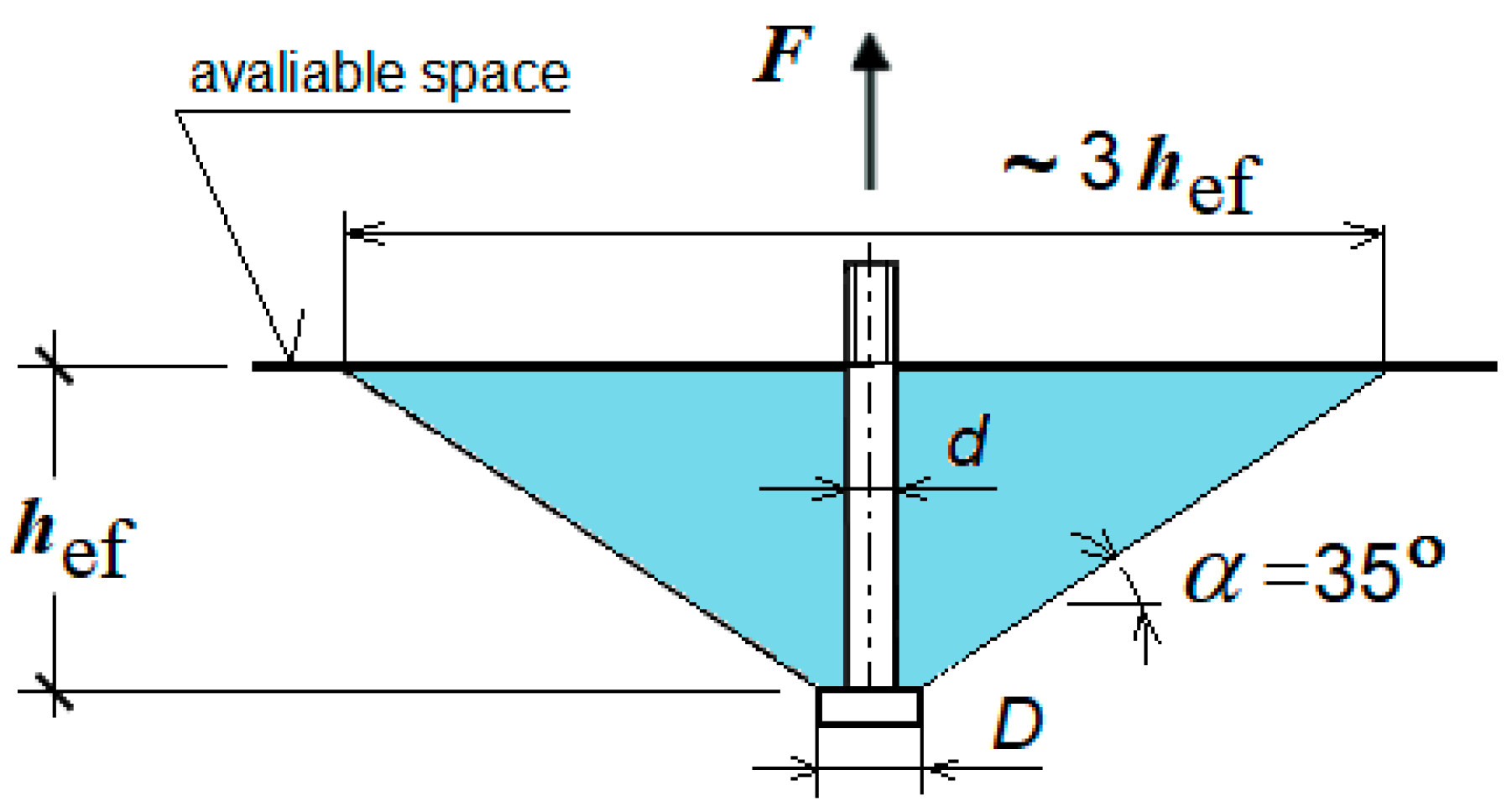
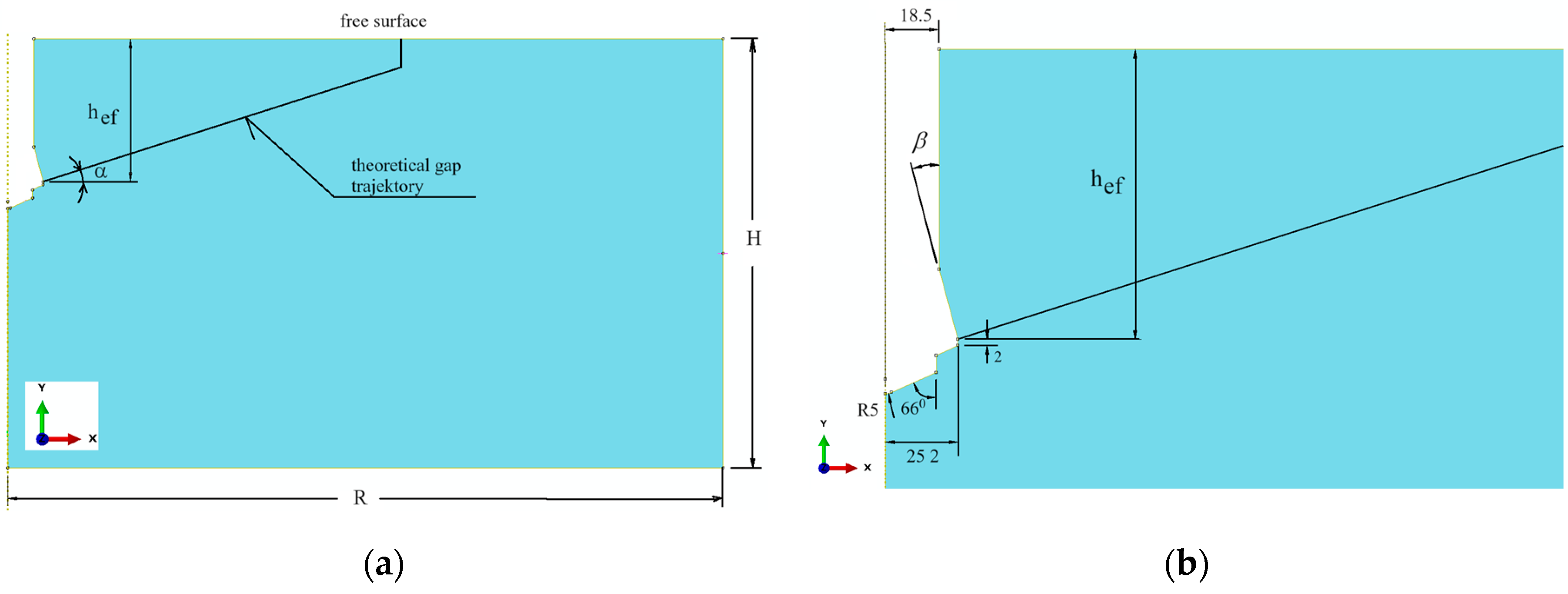
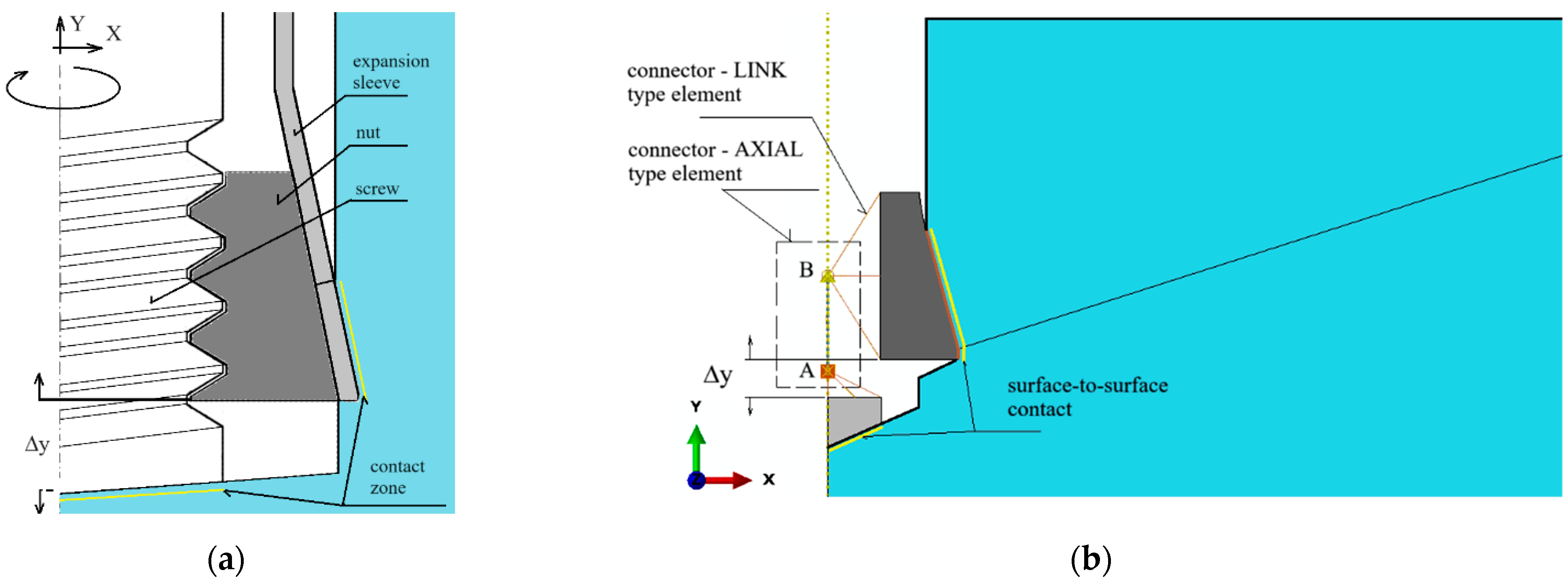

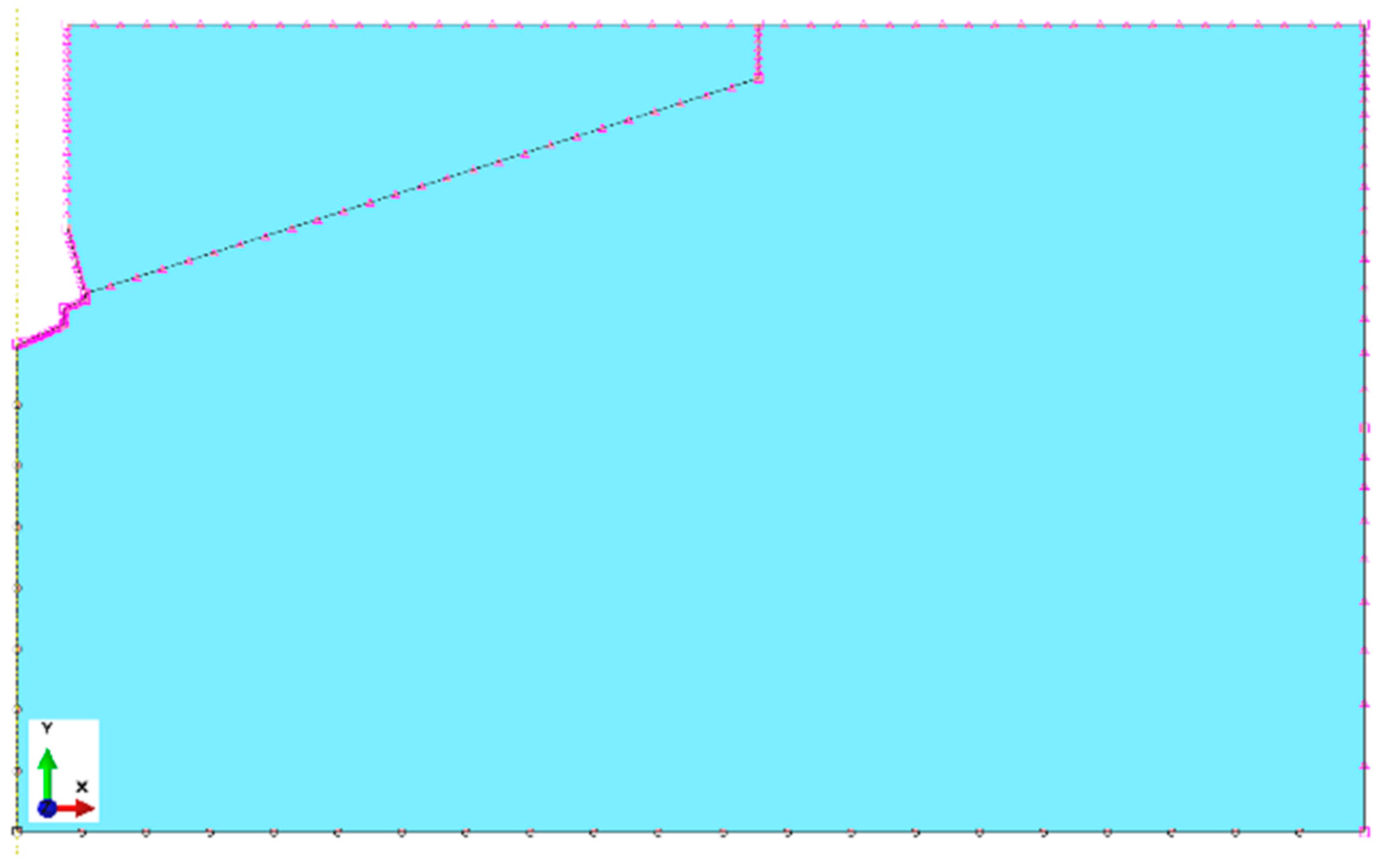

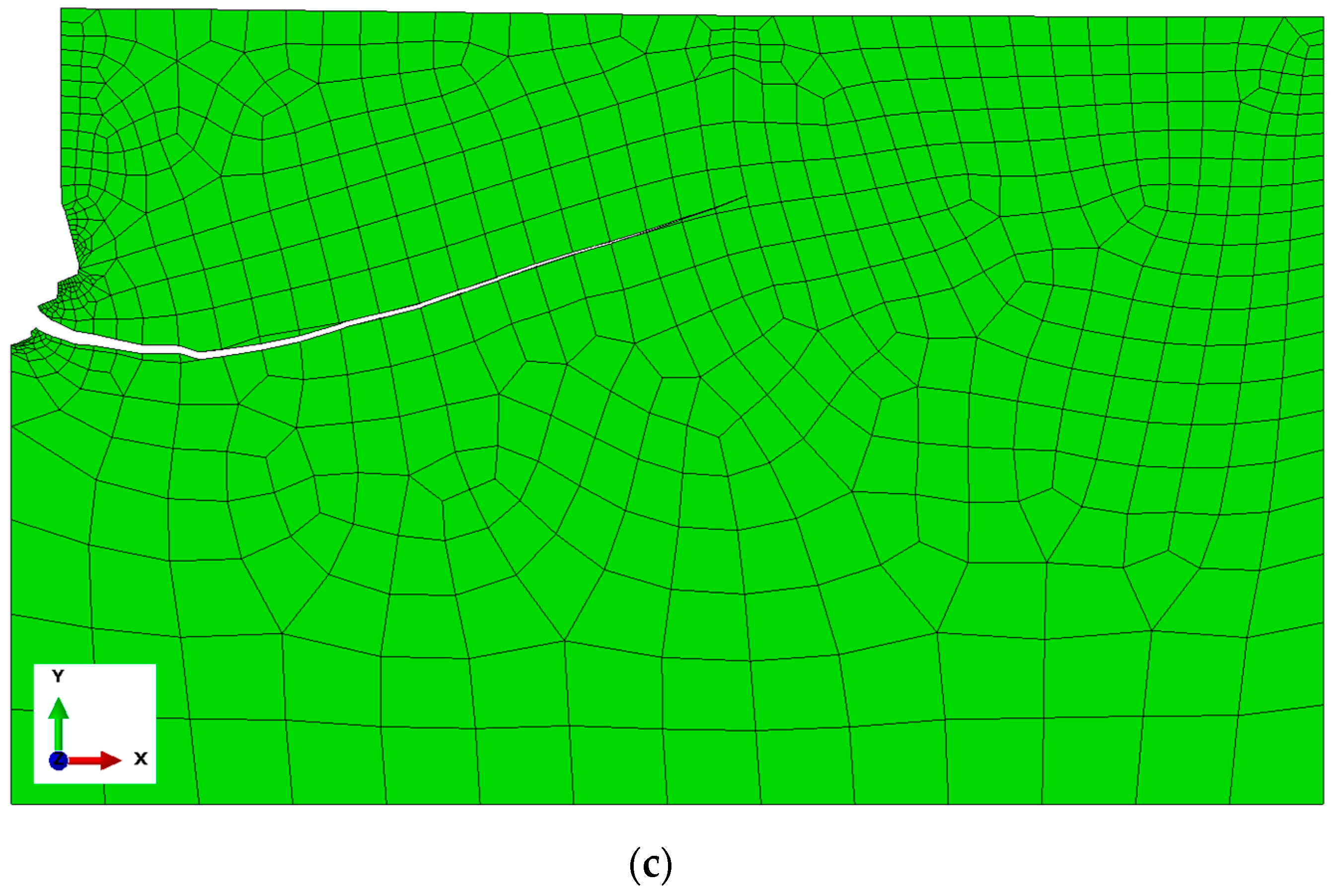
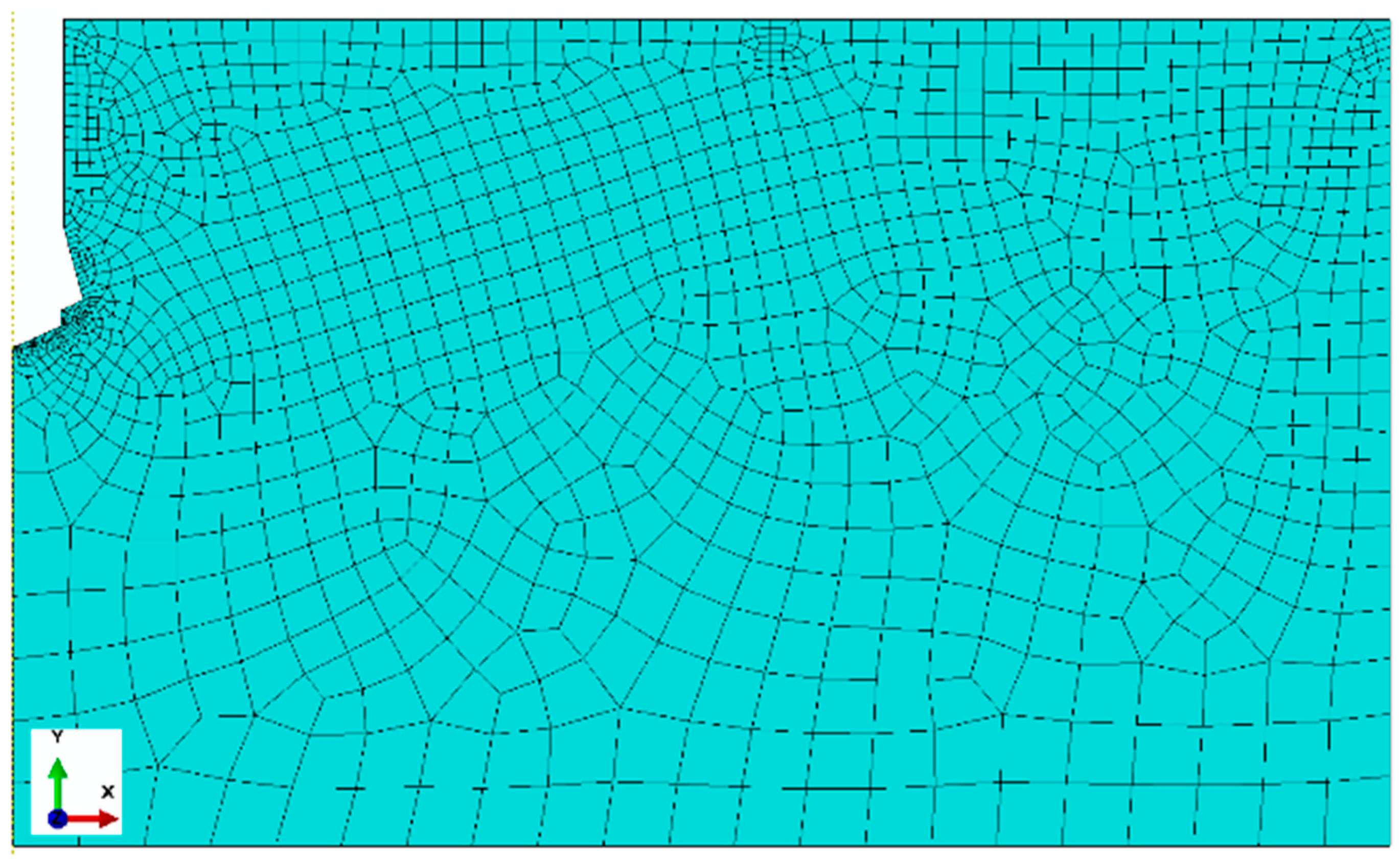

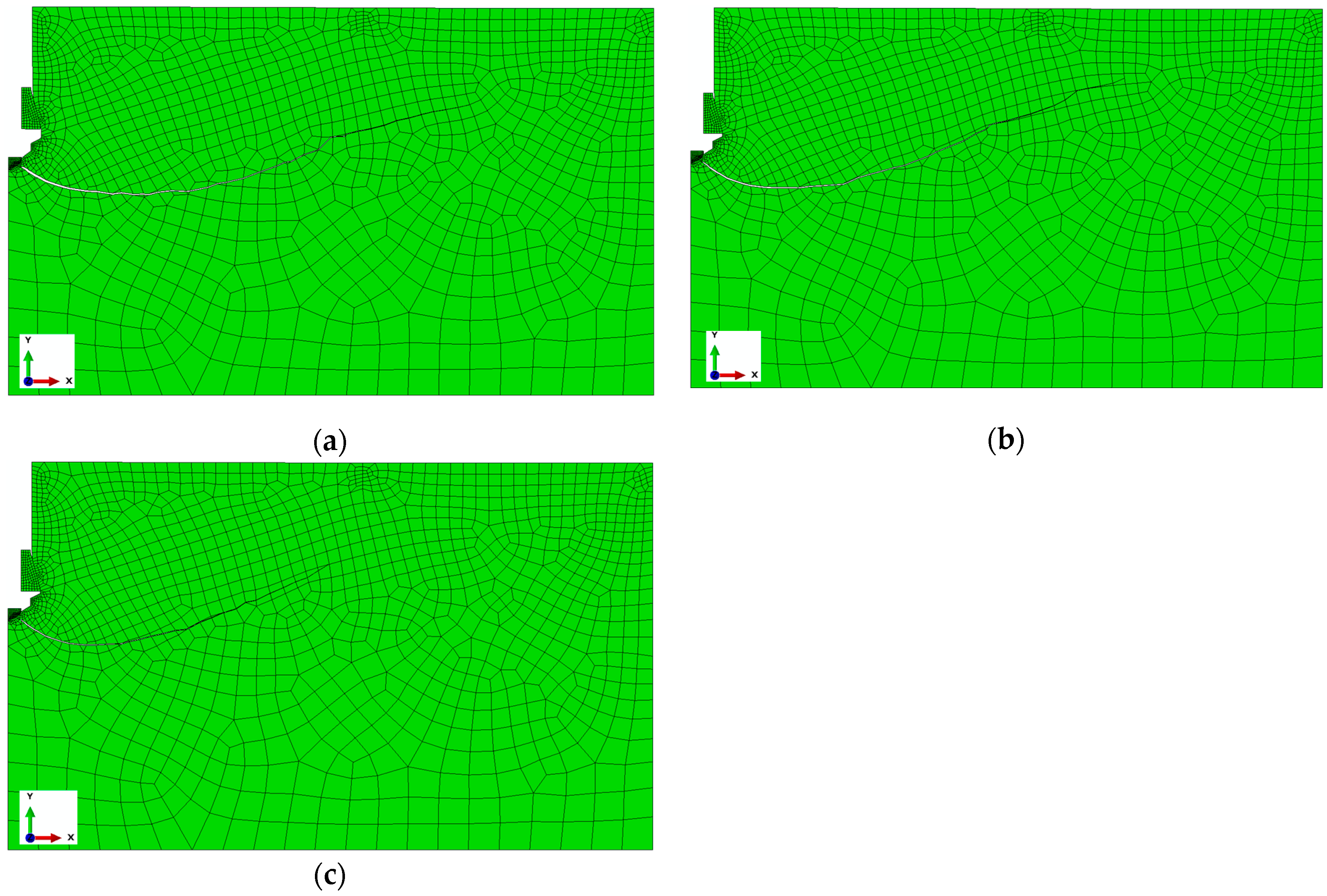
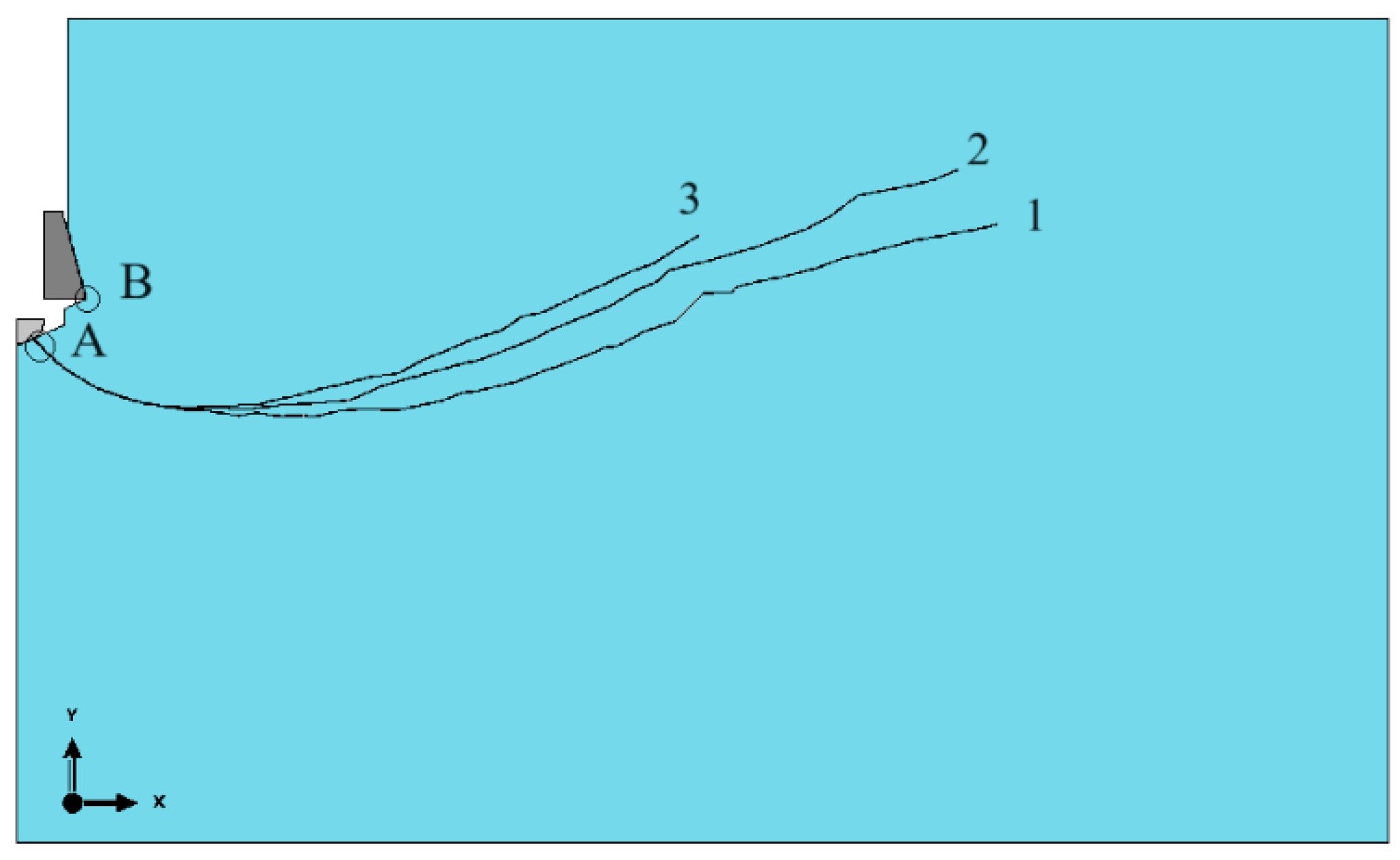
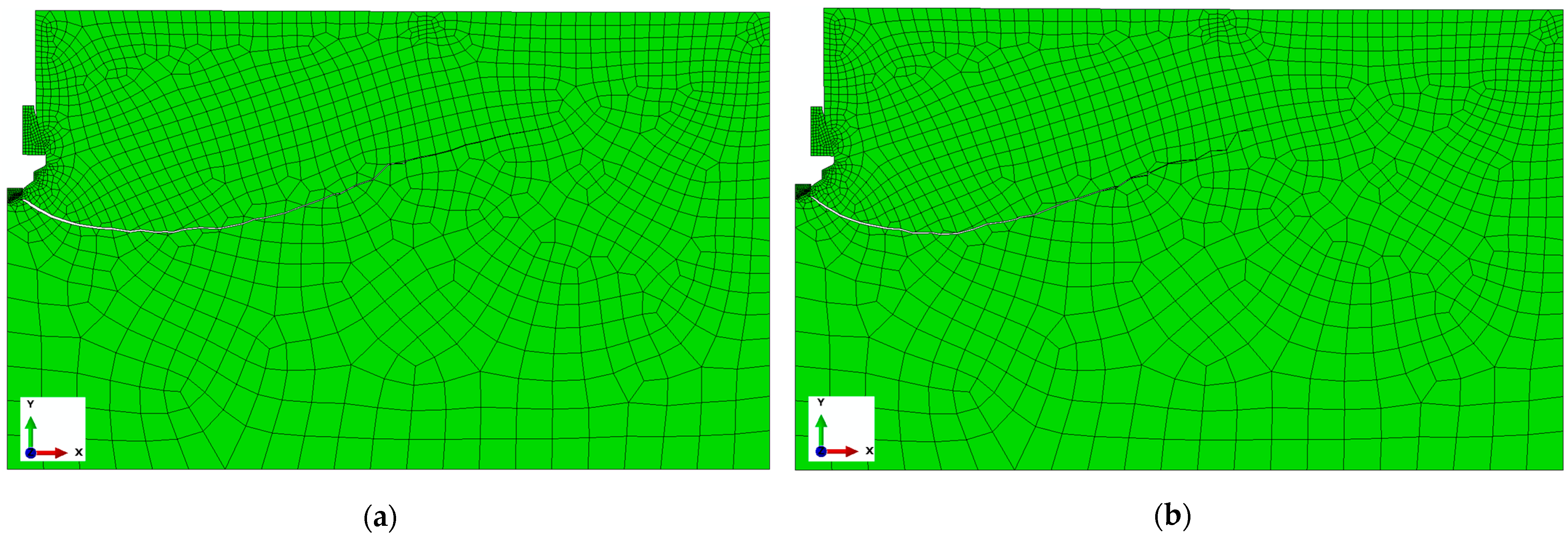
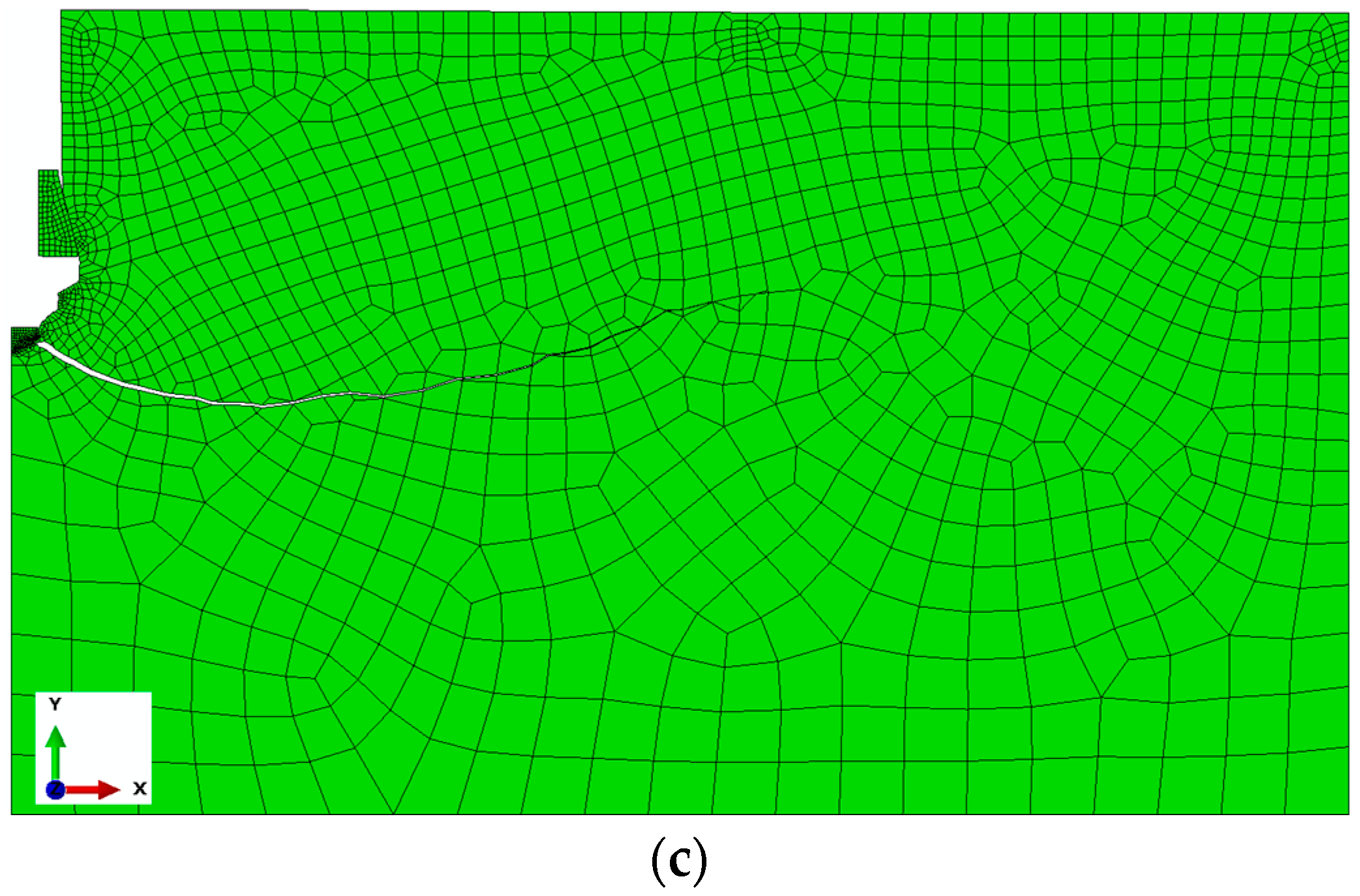
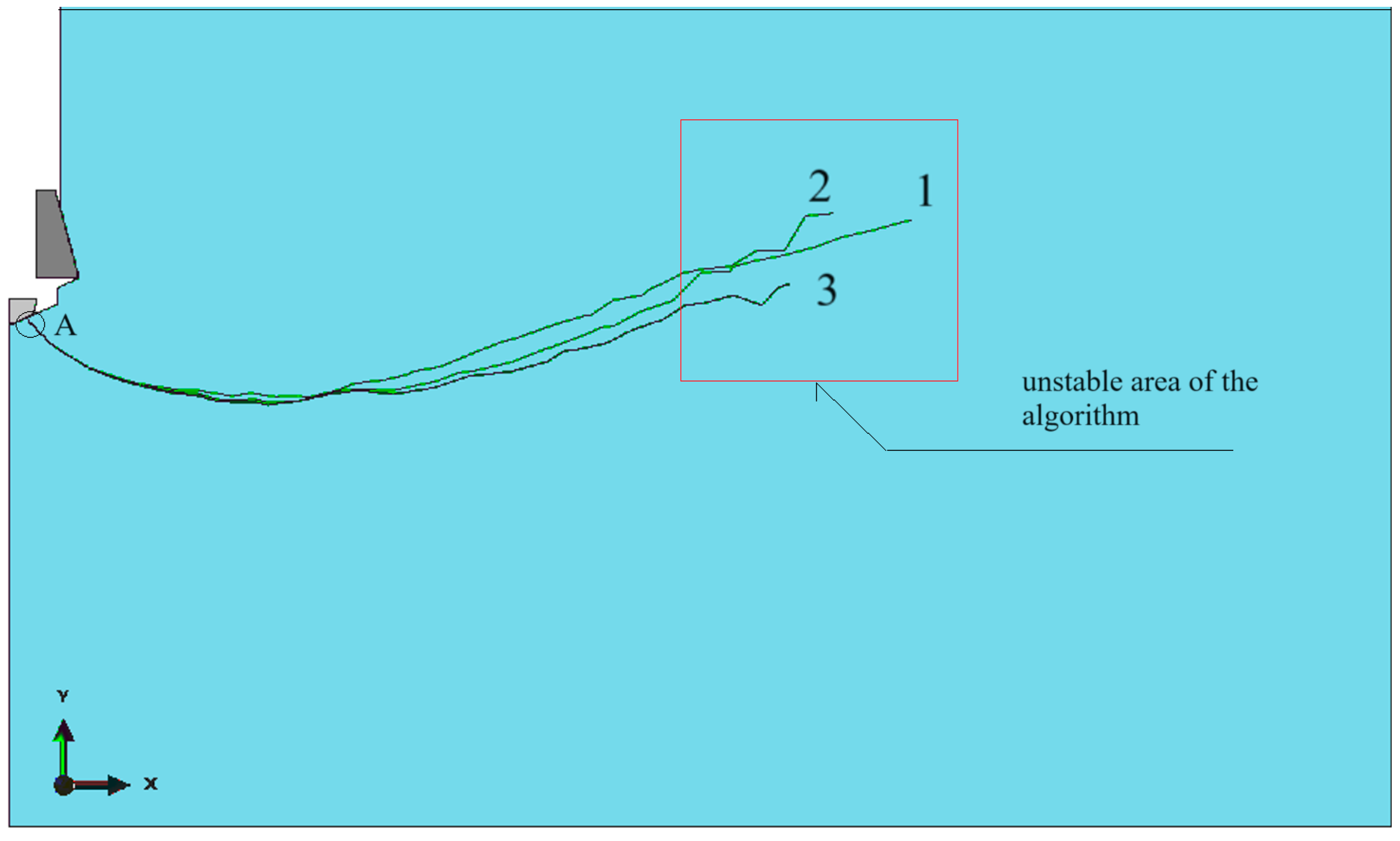
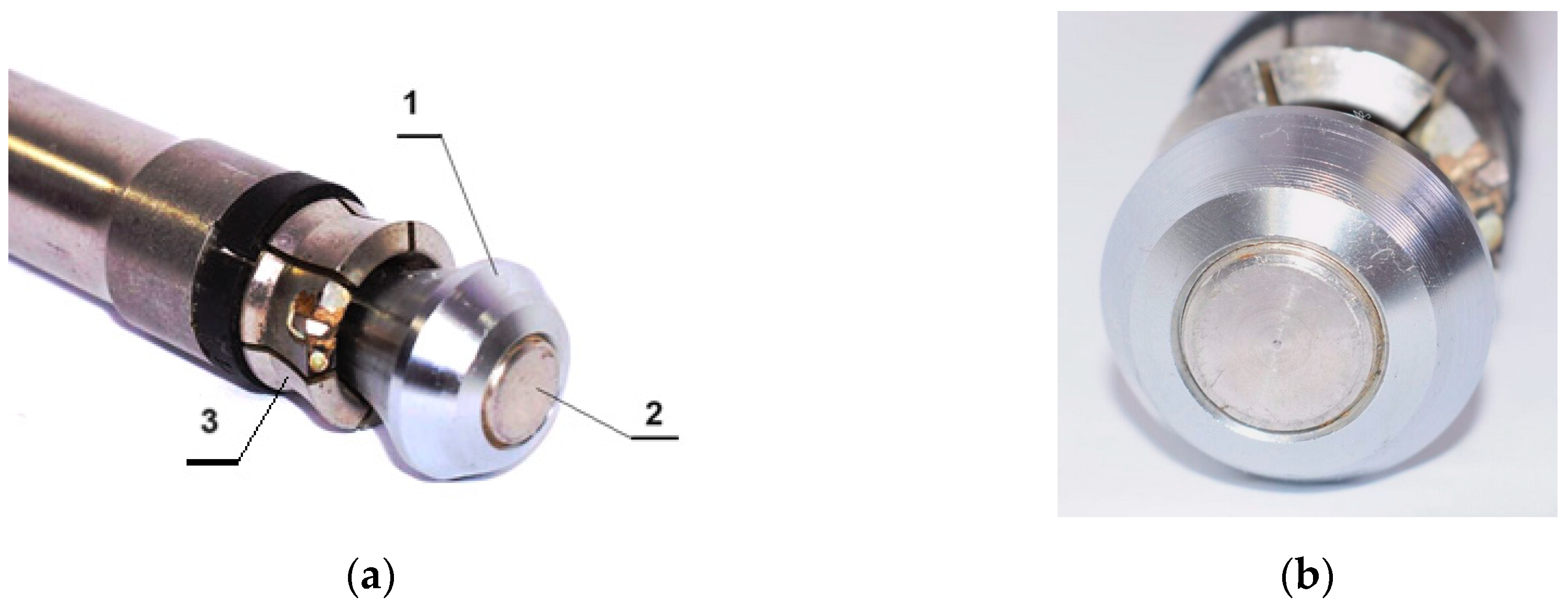

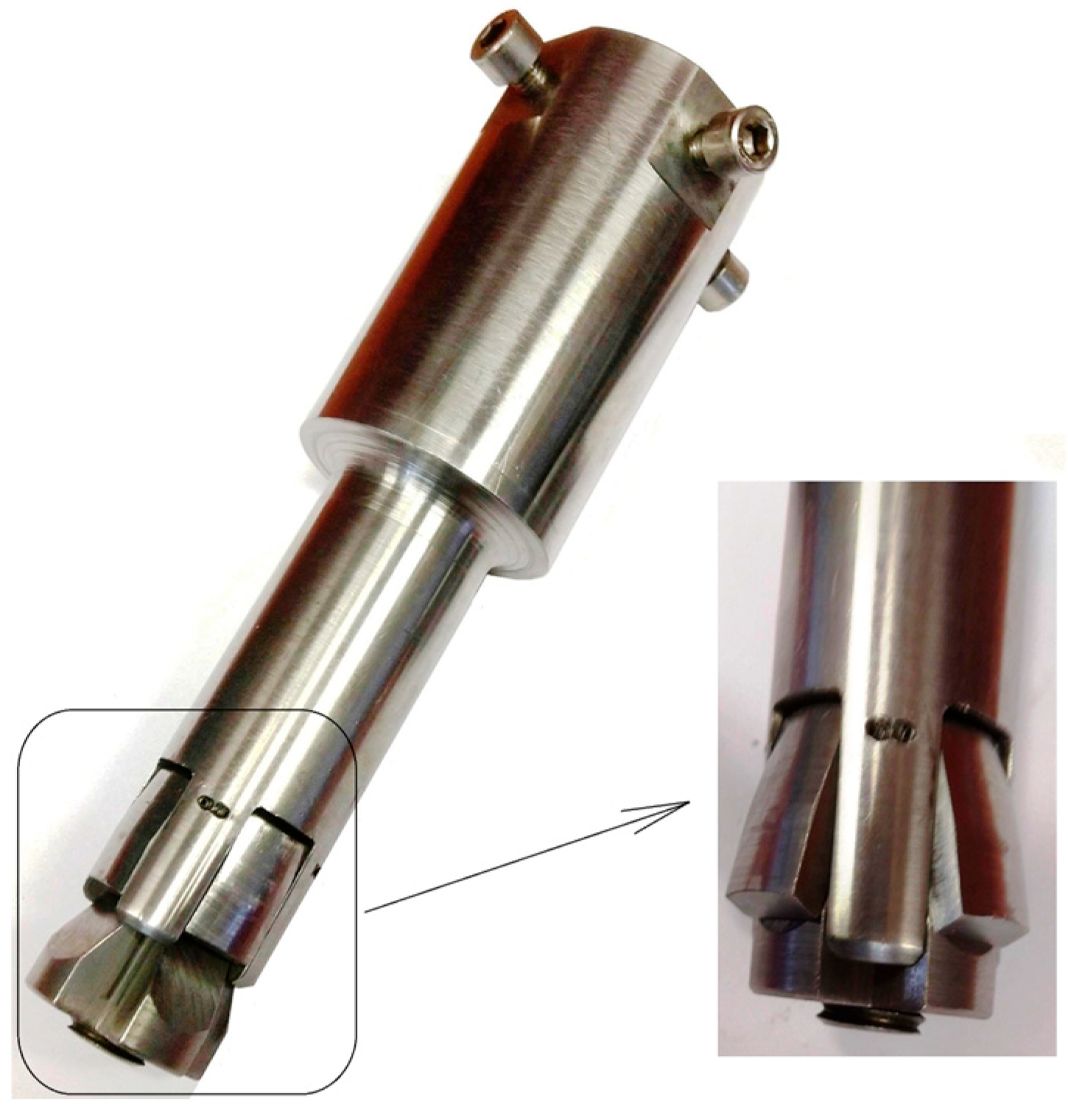
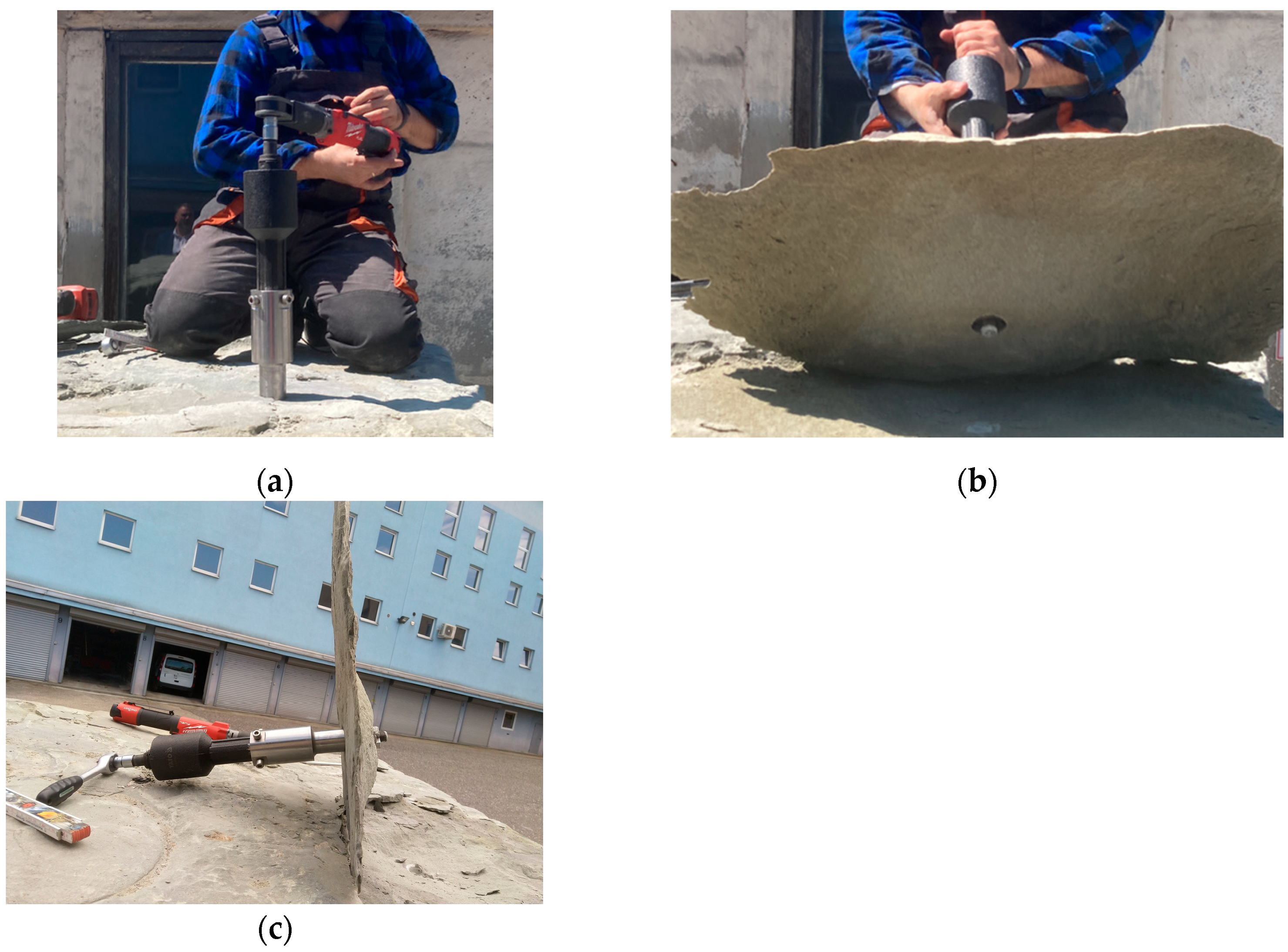

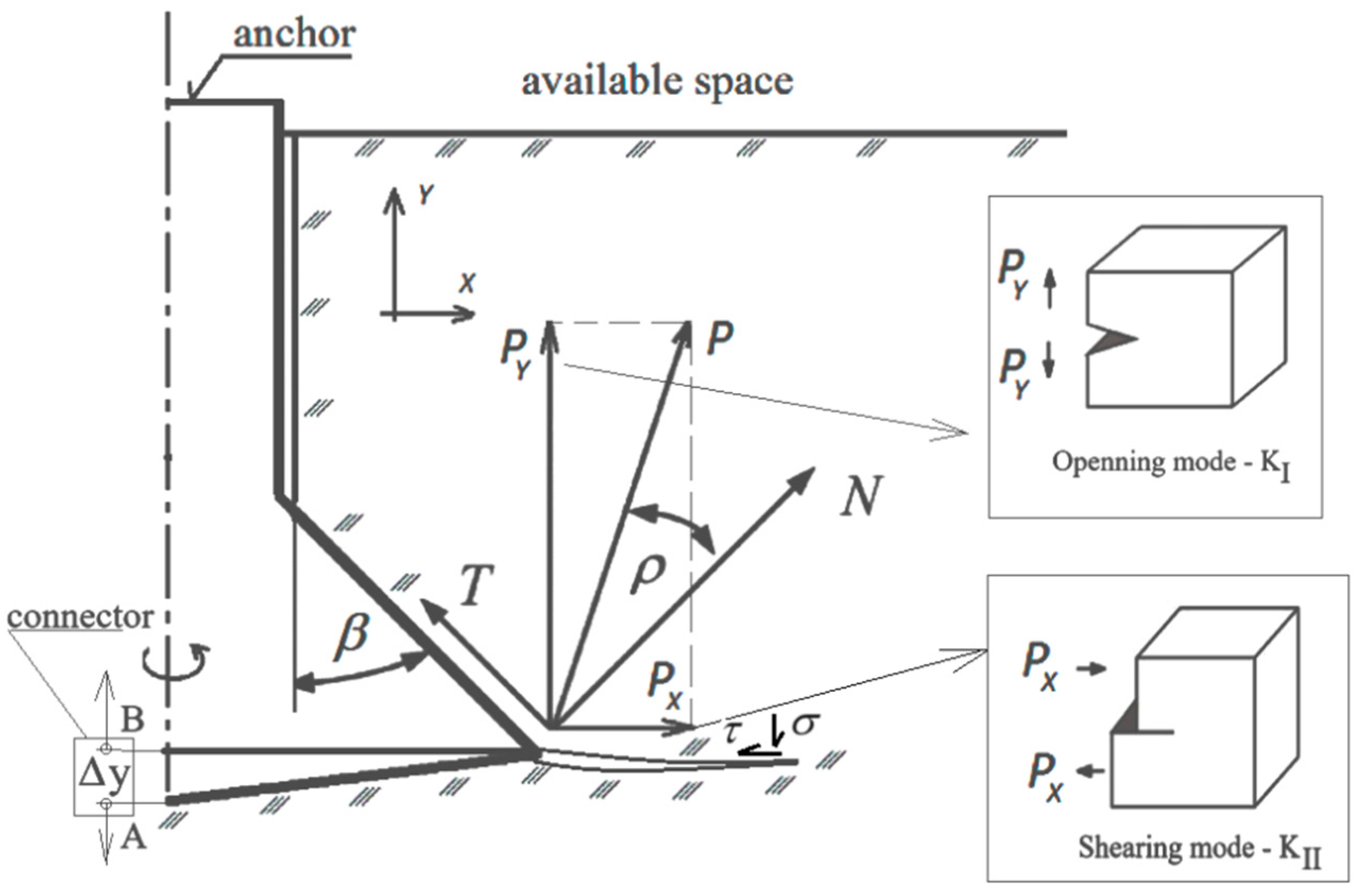
Disclaimer/Publisher’s Note: The statements, opinions and data contained in all publications are solely those of the individual author(s) and contributor(s) and not of MDPI and/or the editor(s). MDPI and/or the editor(s) disclaim responsibility for any injury to people or property resulting from any ideas, methods, instructions or products referred to in the content. |
© 2024 by the authors. Licensee MDPI, Basel, Switzerland. This article is an open access article distributed under the terms and conditions of the Creative Commons Attribution (CC BY) license (https://creativecommons.org/licenses/by/4.0/).
Share and Cite
Wójcik, A.; Jonak, K.; Karpiński, R.; Jonak, J.; Kalita, M.; Prostański, D. Mechanism of Rock Mass Detachment Using Undercutting Anchors: A Numerical Finite Element Method (FEM) Analysis. Materials 2024, 17, 4468. https://doi.org/10.3390/ma17184468
Wójcik A, Jonak K, Karpiński R, Jonak J, Kalita M, Prostański D. Mechanism of Rock Mass Detachment Using Undercutting Anchors: A Numerical Finite Element Method (FEM) Analysis. Materials. 2024; 17(18):4468. https://doi.org/10.3390/ma17184468
Chicago/Turabian StyleWójcik, Andrzej, Kamil Jonak, Robert Karpiński, Józef Jonak, Marek Kalita, and Dariusz Prostański. 2024. "Mechanism of Rock Mass Detachment Using Undercutting Anchors: A Numerical Finite Element Method (FEM) Analysis" Materials 17, no. 18: 4468. https://doi.org/10.3390/ma17184468
APA StyleWójcik, A., Jonak, K., Karpiński, R., Jonak, J., Kalita, M., & Prostański, D. (2024). Mechanism of Rock Mass Detachment Using Undercutting Anchors: A Numerical Finite Element Method (FEM) Analysis. Materials, 17(18), 4468. https://doi.org/10.3390/ma17184468






